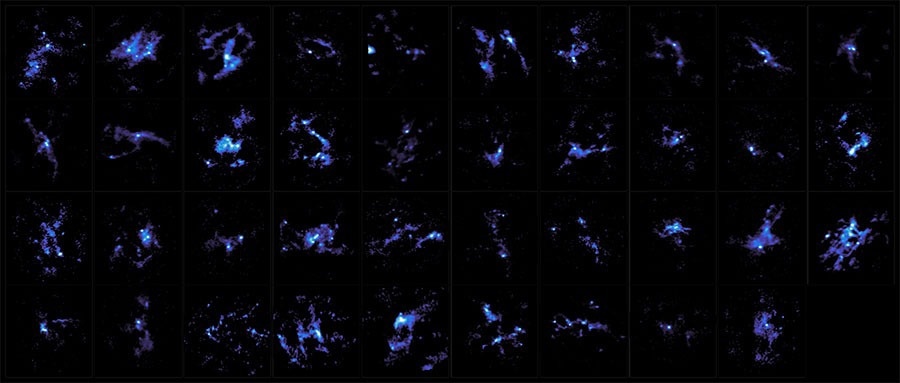Astronomers have discovered 39 interstellar clouds where massive stars are predicted to develop. This big data set demonstrates that the established paradigm of low-mass star formation must be expanded to explain high-mass star formation.

Dust emission maps for 39 IRDCs where massive stars are expected to form in the future. Image Credit: ALMA (ESO/NAOJ/NRAO), K. Morii et al.
This shows that the production of high-mass stars differs fundamentally from the formation of low-mass stars, and it is not merely a matter of size.
The discharge of heavy metals and the shock waves created when a large star explodes in a supernova play crucial roles in the evolution of the Universe. Despite their significance, the formation of massive stars is still poorly understood because of their scarcity.
A team led by Kaho Morii, Patricio Sanhueza, and Fumitaka Nakamura used the Atacama Large Millimeter/submillimeter Array (ALMA) to examine 39 infrared dark clouds (IRDCs) to better understand massive star formation.
IRDCs are enormous, frigid, and thick clouds of gas and dust that are hypothesized to be the locations of massive star formations.
The researchers concentrated on clouds that showed no indicators of star formation to understand the early stages of star creation before nascent stars ignite. The scientists discovered almost 800 stellar seeds, known as molecular cloud cores, in the 39 clouds, which astronomers believe will grow into stars.
If high-mass stars develop similarly to the more well-known low-mass stars, then 99% of these cores are insufficiently massive to become high-mass stars. These results provide credence to the hypothesis that high-mass stars develop through a different process than low-mass stars.
The group also looked into the distribution of cores. High-mass stars are concentrated in stellar clusters, but low-mass stars are dispersed widely. However, this research showed that there is no preference between locations of higher-mass cores and lower-mass cores.
Denser cores, on the other hand, typically concentrate locally. This implies that denser cores, not more massive ones, may be the source of high-mass stars and that they could grow more quickly than less dense ones.
Journal Reference
Morii, K., et al. (2023) The ALMA Survey of 70 μm Dark High-mass Clumps in Early Stages (ASHES). IX. Physical Properties and Spatial Distribution of Cores in IRDCs. The Astrophysical Journal. doi:10.3847/1538-4357/acccea.